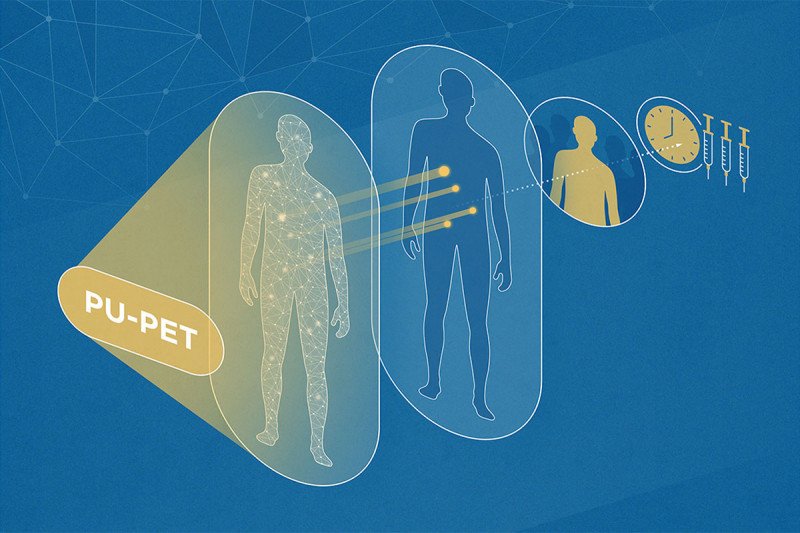
Targeted therapy has become an important player in the collection of treatments for cancer. But sometimes it’s difficult for doctors to determine whether a person’s tumor has the right target or how much of a drug is actually reaching it.
A multidisciplinary team of doctors and scientists from Memorial Sloan Kettering has discovered an innovative technique for noninvasively visualizing where a targeted therapy is going in the body. This method can also measure how much of it reaches the tumor. What makes this development even more exciting is that the drug they are studying employs an entirely new approach for stopping cancer growth. The work was published on October 24 in Cancer Cell.
“This paper reports on the culmination of almost 15 years of research,” says first author Naga Vara Kishore Pillarsetty, a radiochemist in the Department of Radiology. “Everything about this drug — from the concept to the clinical trials — was developed completely in-house at MSK.”
“Our research represents a new role for the field of radiology in drug development,” adds senior author Mark Dunphy, a nuclear medicine doctor. “It’s also a new way to provide precision oncology.”
Targeting a Unique Protein Network
The drug being studied, called PU-H71, was developed by the study’s co-senior author Gabriela Chiosis. Dr. Chiosis is a member of the Chemical Biology Program in the Sloan Kettering Institute. PU-H71 is being evaluated in clinical trials for breast cancer and lymphoma, and the early results are promising.
“We always hear about how DNA and RNA control a cell’s fate,” Dr. Pillarsetty says. “But ultimately it is proteins that carry out the functions that lead to cancer. Our drug is targeting a unique network of proteins that allow cancer cells to thrive.”
Most targeted therapies affect individual proteins. In contrast, PU-H71 targets something called the epichaperome. Discovered and named by Dr. Chiosis, the epichaperome is a communal network of proteins called chaperones.
Chaperone proteins help direct and coordinate activities in cells that are crucial to life, such as protein folding and assembly. The epichaperome, on the other hand, does not fold. It reorganizes the function of protein networks in cancer, which enables cancer cells to survive under stress.
Previous research from Dr. Chiosis and Monica Guzman of Weill Cornell Medicine provided details on how PU-H71 works. The drug targets a protein called the heat shock protein 90 (HSP90). When PU-H71 binds to HSP90 in normal cells, it rapidly exits. But when HSP90 is incorporated into the epichaperome, the PU-H71 molecule becomes lodged and exits more slowly. This phenomenon is called kinetic selectivity. It helps explain why the drug affects the epichaperome. It also explains why PU-H71 appears to have fewer side effects than other drugs aimed at HSP90.
At the same time, this means that PU-H71 works only in tumors where an epichaperome has formed. This circumstance led to the need for a diagnostic method to determine which tumors carry the epichaperome and, ultimately, who might benefit from PU-H71.
A New Way to Match Drugs to Tumors
In the Cancer Cell paper, the investigators report the development of a precision medicine tactic that uses a PET tracer with radioactive iodine. It is called [124I]-PU-H71 or PU-PET. PU-PET is the same molecule as PU-H71 except that it carries radioactive iodine instead of nonradioactive iodine. The radioactive version binds selectively to HSP90 within the epichaperome in the same way that the regular drug does. On a PET scan, PU-PET displays the location of the tumor or tumors that carry the epichaperome and therefore are likely to respond to the drug. Additionally, when it’s given along with PU-H71, PU-PET can confirm that the drug is reaching the tumor.
“This research fits into an area that is sometimes called theranostics or pharmacometrics,” Dr. Dunphy says. “We have found a very different way of selecting patients for targeted therapy.”
He explains that with traditional targeted therapies, a portion of a tumor is removed with a biopsy and then analyzed. Biopsies can be difficult to perform if the tumor is located deep in the body. Additionally, people with advanced disease that has spread to other parts of the body may have many tumors, and not all of them may be driven by the same proteins. “By using this imaging tool, we can noninvasively identify all the tumors that are likely to respond to the drug, and we can do it in a way that is much easier for patients,” Dr. Dunphy says.
The researchers explain that this type of imaging also allows them to determine the best dose for each person. For other targeted therapies, doctors look at how long a drug stays in the blood. “But that doesn’t tell you how much is getting to the tumor,” Dr. Pillarsetty says. “By using this imaging agent, we can actually quantify how much of the drug will reach the tumor and how long it will stay there.”
Plans for further clinical trials of PU-H71 are in the works. In addition, the technology reported in this paper may be applicable for similar drugs that also target the epichaperome.









